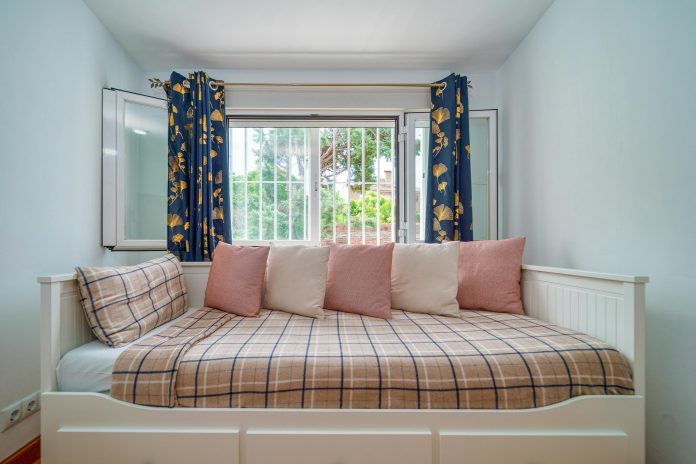Choosing the right furniture for your living space can be a challenging task, especially when it comes to versatile pieces like day beds and sofa beds. Both options offer dual functionality, serving as seating during the day and sleeping surfaces at night. Day beds typically provide a more seamless transition between sofa and bed, making them ideal for frequent use as both seating and sleeping arrangements.
Sofa beds, on the other hand, often offer larger sleeping surfaces and may be better suited for occasional guest accommodations. When considering which option is right for you, you’ll discover stylish daybeds tend to have a more decorative appearance, while sofa beds often blend in with traditional living room furniture.
Key Takeaways
- Day beds offer easier conversion and are suitable for daily use as both seating and sleeping surfaces
- Sofa beds typically provide larger sleeping areas and are better for occasional guest accommodations
- Consider space, intended use, and style preferences when choosing between day beds and sofa beds
Design and Space Considerations
Day beds and sofa beds offer distinct advantages for maximizing space and enhancing interior design. Their unique characteristics influence room layout, aesthetics, and functionality.
Optimizing Limited Space
Day beds excel in compact spaces due to their slim profile. Typically measuring 39 inches wide by 75 inches long, they fit well in small bedrooms or home offices. Sofa beds require more room, usually 54-89 inches wide when closed. However, they transform into full or queen-size beds, accommodating multiple guests.
In studio apartments, day beds double as seating and sleeping areas without sacrificing floor space. Sleeper sofas work better in larger living rooms, providing comfortable seating by day and guest accommodations at night.
For multipurpose rooms, consider a day bed with storage drawers underneath. This feature maximizes space efficiency while keeping extra bedding or personal items organized and out of sight.
Aesthetics and Interior Design
Day beds often feature a more casual, relaxed look. Their open design with one or three sides bordered by arms or a backrest allows for creative styling with throw pillows and blankets. This versatility makes them suitable for various decor styles, from bohemian to contemporary.
Sofa beds blend seamlessly into living room settings. Available in diverse styles, fabrics, and colors, they can match existing furniture or serve as statement pieces. High-end models offer tailored looks indistinguishable from regular sofas when closed.
Consider the room’s color scheme and overall design theme when selecting either option. Neutral tones provide flexibility, while bold colors or patterns can add visual interest to a space.
Furniture Piece as a Focal Point
A well-chosen day bed or sofa bed can serve as a room’s focal point. Day beds, with their unique silhouette, draw attention in home offices or guest rooms. Positioning them against a statement wall or under a window creates an inviting nook for reading or relaxation.
Sleeper sofas command attention in living areas. Opt for models with tufted upholstery or distinctive arm designs to enhance visual appeal. Accessorize with coordinating throw pillows and a stylish area rug to anchor the piece within the room.
For added impact, select a day bed or sofa bed in a contrasting color or material to the surrounding decor. This creates visual interest and highlights the furniture’s dual functionality.
Functional Aspects and Comfort
Day beds and sofa beds offer distinct advantages in terms of functionality and comfort. Both provide sleeping and seating options, but differ in their design, mattress types, and versatility.
Mattress and Sleeping Experience
Day beds typically use twin-size mattresses, offering a comfortable sleeping surface for one person. These mattresses are often thicker and more supportive than those found in sofa beds. Some day beds feature memory foam or innerspring mattresses for enhanced comfort.
Sofa beds come with hidden mattresses that fold out. These tend to be thinner to accommodate the folding mechanism. Full-size or queen-size options are common, accommodating two sleepers. Mattress toppers can improve comfort on sofa beds.
Day beds generally provide a better sleeping experience due to their dedicated mattress design. Sofa beds, while functional, may have seams or support bars that can be felt through the mattress.
Dual Functionality and Versatility
Day beds excel as seating areas during the day and transform into beds at night without any folding mechanisms. Some models include a trundle bed underneath for additional sleeping space.
Sofa beds function primarily as seating and convert to beds when needed. Their fold-out design allows them to offer larger sleeping surfaces, often accommodating two adults comfortably.
Both options maximize space in small rooms or studios. Day beds are ideal for guest rooms or children’s rooms, while sofa beds suit living rooms and home offices.
Maintenance and Durability
Day beds are generally more durable due to their simpler construction. With fewer moving parts, they require less maintenance and are less prone to mechanical issues.
Sofa beds have more complex mechanisms that may require occasional lubrication or repair. Their mattresses, being folded regularly, may wear out faster than day bed mattresses.
Cleaning is typically easier for day beds, as their mattresses are always accessible. Sofa bed mattresses can be challenging to clean due to their hidden nature when folded.
Both options benefit from mattress protectors to extend lifespan and ease maintenance. Regular vacuuming and spot-cleaning help maintain appearance and hygiene for both day beds and sofa beds.
Conclusion
Day beds and sofa beds offer different solutions for versatile seating and sleeping arrangements. Day beds provide a comfortable seating option that easily converts to a single bed, making them ideal for smaller spaces or guest rooms. Sofa beds offer hidden storage and transform into larger sleeping surfaces, suitable for accommodating multiple guests. The choice between the two depends on individual needs, available space, and intended use.


























